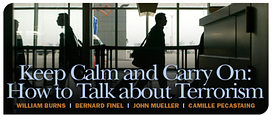While it is easy to agree on the benefits to better educating citizens about risks from terrorism, there are many paths to enlightenment, some more practical than others. The task would not just be about preparing the people most likely to be exposed to an emergency, namely those in the largest metropolitan areas, but about educating the entire nation so that citizens’ political responses to the next attack will be better calibrated to the risk. It is particularly essential to explain that terrorists are not killers by vocation but provocateurs, and that nothing better serves their purpose than an overreaction.
The most sensible way to get there would be to incorporate a course on risk and probability in the secondary school curriculum, as part of civic education. As it happens, there are abundant risks in the United States—natural catastrophes, industrial catastrophes, epidemics, and human rampages, from killing sprees to terrorism—so it is possible to incorporate education on terrorism into a broader framework of homeland security, and avoid singling it out as an existential threat.
The only problem is that risk alertness is like a vaccine: it needs to be refreshed. You need a few hurricanes, a few earthquake tremors, a few shootouts now and then to remind that the risk is there and that behaviors should be adapted to it. The best efforts to educate citizens about the reality of the risk they face from terrorism may become useless after a long period without incident. And when the incident occurs—10, 20 years down the road—no one will be prepared, leaving the field wide open for the kind of overreaction we have witnessed.
There is one puzzle with regard to the recent experience in the United States. The attacks of the 1990s were characterized by underreaction—and underreaction was robust. If we add attacks against American targets overseas (twice in Saudi Arabia, in Kenya, in Tanzania) and failed attacks (the bridges and tunnels attack, the Millennium plot) to the attacks that did occur on U.S. soil, the existence of a risk from terrorism was very apparent at the time, even though the risk of exposure for each American was very low.
Then came the overreaction after 2001. There are several explanations possible for the complete reversal of outcome. One is the temperament of the leadership at the time, which influenced the nation’s response. Another is the effect of the unique imagery and pathos of the New York attack, which may have tilted the scales. A third explanation is the nature of the enemy: Americans killing Americans (Ted Kaczynski, Timothy McVeigh, Eric Rudolph) in the United States was a low emotion risk; Islamists killing Americans in Muslim lands was also a low emotion risk. But the possibility of an alien fifth column already in the country and ready to strike may have been overwhelming.
Those powerful emotions died out when it became clear that this fifth column never existed. In the end, the appetite to pursue Jihadists into the slums of Baghdad and in the caves of the Pamirs was limited, and support for Bush’s wars quickly waned. That says something of how Americans envision—and “feel about”—the safety of their homeland. Dr. Finel ventured to explore the national temperament: imperial reach is not part of it.

